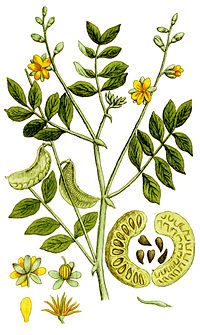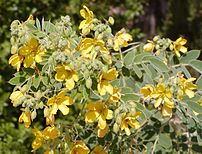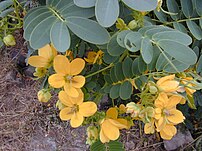Senna (plant)
From Wikipedia, the free encyclopedia
(Redirected from Senna (herb))
| Senna | |
|---|---|
 | |
| Senna alexandrina | |
| Scientific classification | |
| Kingdom: | Plantae |
| Division: | Angiospermae |
| (unranked): | Eudicots |
| Order: | Fabales |
| Family: | Fabaceae |
| Subfamily: | Caesalpinioideae |
| Tribe: | Cassieae |
| Subtribe: | Cassiinae |
| Genus: | Senna Mill. |
| Type species | |
| Senna alexandrina Mill. | |
| Species | |
| Around 250, see text | |
| Synonyms | |
| Cathartocarpus (partim) Chamaefistula Diallobus Earleocassia Herpetica Isandrina Palmerocassia Pseudocassia | |
Contents[hide] |
[edit] Description
The following description is rather cursory and based mostly on Irwin and Barneby (1982), [4] but partly on Marazzi (2006) [1].The sennas are typically shrubs or subshrubs, some becoming scandent when growing into other vegetation. Some are herbs or small trees. Many species have extrafloral nectaries.
The leaves are paripinnately compound, the leaflets opposite. The inflorescence is a raceme, or some arrangement or racemes. The pedicels lack bracteoles.
The flowers produce no nectar. They are buzz pollinated and offer pollen as a reward to pollinators. They are often asymmetric. The petals are 5 in number, similar to each other, yellow, or rarely white.
The stamens may be as few as 4, but usually there are 10. When 10, they occur in 3 sets. The 3 adaxial stamens are staminodial. The 4 medial stamens are smaller than the 3 abaxial stamens. The anthers are basifixed and open by two terminal pores or short slits.
The gynoecium is often enantiostylous; that is, it is deflected laterally to the right or left. This makes the flower asymmetric, but the perianth and the androecium may be asymmetrical as well.
The fruit is a legume, indehiscent or tardily dehiscent.
[edit] Affinities
Chamaecrista, Cassia, and Senna form a monophyletic group which some authors have called Cassia sensu lato. [5] In 1982, Howard Samuel Irwin and Rupert Charles Barneby called it subtribe Cassiinae of their tribe Cassieae. [4] Cassieae, sensu Irwin and Barneby, contains 21 genera and is now known to be polyphyletic. [5] Most authors continue to use the Irwin and Barneby classification because a subsequent revision of Fabaceae has yet to be published. [5][edit] Circumscription
The genus Senna has had a rather complex taxonomic history. [6] What is now known as Senna was included by Linnaeus in his concept of Cassia in Species Plantarum in 1753. [7] Philip Miller segregated Senna from Cassia in 1754 in the fourth edition of The Gardeners Dictionary. [8] Until Irwin and Barneby published their paper in 1982, many authors, following Linnaeus, did not recognize Senna and Chamaecrista, but included them in a broadly circumscribed Cassia sensu lato. Molecular phylogenetic analyses of DNA sequences have shown that Chamaecrista, Cassia, and Senna are all monophyletic, but the relationships between these three genera have not been resolved. [1] They are therefore shown in phylogenetic trees as a tritomy.The division of Senna into sections and other infrageneric groups is in need of major revision, but none has been published since Irwin and Barneby published their classification in 1982.
[edit] Ecology and uses
Senna species make good ornamental plants and are used for landscape gardening. The wide variety of species and ecological adaptations makes at least a handful of sennas suitable for any climate warmer than cool-temperate.Cassia gum - a commonly-used thickening agent -, despite its name is actually from Chinese Senna (S. obtusifolia) seeds. In some Southeast Asian cuisines (particularly those of Thailand and Laos), the leaves and flowers of Siamese Senna (S. siamea, called khi-lek in Thai), either fresh or pickled in brine, are used in cooking, particularly in gaeng khi-lek (khi-lek curry). [9]
Another senna, Senna italica ssp. italica (= Cassia obovata), often called "neutral henna", is used as a hair treatment with effects similar to henna but without the red color. The active component is an anthraquinone derivative called chrysophanic acid, which is also found in higher concentrations in rhubarb root. It adds a slight yellow color.
Some species of Senna are notable for being host to caterpillars of certain Lepidoptera species, for example:
- Ascalapha odorata (Black Witch Moth) – recorded on Candle Bush (S. alata)
- Astraptes fulgerator (Two-barred Flasher) – recorded on Candle Bush (S. alata), S. cobanensis, S. hayesiana, S. pallida, S. papillosa, S. undulata and probably others [note 1]
- Catopsilia pomona (Common Emigrant, Lemon Emigrant) – recorded on Candle Bush (S. alata) and possibly others
- Catopsilia pyranthe (Mottled Emigrant) – recorded from Candle Bush (S. alata), Avaram Senna (S. auriculata), S. garrettiana and probably others
- Phoebis sennae (Cloudless Sulphur)[verification needed]
[edit] In medicine
Sennas have for millennia played a major role in herbalism and folk medicine. Alexandrian Senna (S. alexandrina) was and still is a significant item of trans-national trade e.g. by the Ababdeh people and grown commercially, traditionally along the middle Nile but more generally in many regions around the northwestern Indian Ocean.Sennas act as purgatives and are similar to aloe and rhubarb in having as active ingredients anthraquinone derivatives and their glucosides. The latter are called sennosides or senna glycosides. Senna alexandrina is used in modern medicine as a laxative; [10] acting on the lower bowel, it is especially useful in alleviating constipation. It increases the peristaltic movements of the colon by irritating the colonic mucosa. The plants are most often prepared as an infusion. Senna glycosides are listed as ATC code A06AB06 on their own and A06AB56 in combined preparations.
As regards other chemicals, the antiinflammatory compound resveratrol was first isolated from S. quinquangulata,[citation needed] and Siamese Senna S. siamea contains barakol used to counteract aconitine poisoning. Chinese Senna (S. obtusifolia) seeds are also used in Kampō (traditional Japanese medicine) where they are called ketsumei-shi (ケツメイシ, 決明子) or by their Chinese name jué míng zǐ (traditional: 決明子, simplified: 决明子).
The long-standing use of (mainly) Alexandrian Senna is reflected by its presence in many herbal remedies and tonics. These include for example Black draught, Catholicon, Daffy's Elixir, Diasenna (literally meaning "composed of senna") and Swedish bitters. On the other hand, it was contained in more dangerous "medications" such as the highly toxic antihelminthic Lumbricide and - because their purgative effects are a readily-observed "proof" that some concoction "works" - many generally useless and often poisonous "patent medicine".
Senna is also the primary ingredient found in most "dieter's teas". The combination of acting as a stimulant which reduces a dieter's appetite, and the laxative properties that cause food to move through their system before as many calories can be absorbed is a combination that can lead to rapid and even dangerous weight loss.[11] Additionally it's important to be on the lookout for side effects that can start appearing after 7 days of prolonged use.
The stimulant action of sennosides should be taken into account for those who suffer from any conditions where stimulants are contraindicated, such as past heart disease, high blood pressure, anxiety attacks, etc. A (generally invisible and harmless) side effect of taking Senna medication regularly is Melanosis coli, a brown discoloration of the colon wall.
[edit] Selected species

Senna aversiflora flowers

Senna multiglandulosa flower

Coffee Senna (Senna occidentalis) leaf
- Senna acclinis (F.Muell.) Randell[verification needed]
- Senna aculeata (Benth.) H.S.Irwin & Barneby
- Senna alata (L.) Roxb. – Candle Bush, Candelabra Bush, Empress Candle Plant, Candlestick Tree, Ringworm Tree, "candletree"
- Senna alexandrina Mill. – Alexandrian Senna, Egyptian Senna, Tinnevelly Senna, East Indian Senna, sene de la palthe (French)
- Senna angulata (Vogel) H.S.Irwin & Barneby
- Senna appendiculata (Vogel) Wiersema (= S. australis)
- Senna armata (S.Watson) H.S.Irwin & Barneby
- Senna artemisioides (Gaudich. ex DC.) Randell – Silver Senna, Feathery Senna
- Senna auriculata (L.) Roxb. – Avaram Senna, avaram, ranawara
- Senna aversiflora (Herbert) H.S.Irwin & Barneby
- Senna bicapsularis – Rambling Senna, Christmas Bush, Money Bush, Yellow Candlewood
- Senna birostris (Vogel) H.S.Irwin & Barneby
- Senna candolleana (Vogel) H.S.Irwin & Barneby
- Senna cardiosperma (F.Muell.) Randell[verification needed]
- Senna caudata (Standl.) H.S.Irwin & Barneby (Costa Rica, Panama)
- Senna cobanensis (Britton & Rose) H.S.Irwin & Barneby
- Senna corymbosa – Argentine Senna, Argentina Senna, Buttercup Bush, Flowering Senna, (Texas) Flowery Senna, Tree Senna
- Senna covesii (A.Gray) H.S.Irwin & Barneby – Desert Senna, Coues' Senna, Rattleweed
- Senna cumingii (Hook. & Arn.) H.S.Irwin & Barneby
- Senna cuthbertsonii (F.Muell.) Randell[verification needed]
- Senna didymobotrya (Fresen.) H.S.Irwin & Barneby
- Senna domingensis (Spreng.) H.S.Irwin & Barneby (Cuba, Hispaniola)
- Senna excelsa (Schrad) Irwin & Barneby[verification needed]
- Senna fruticosa (Mill.) H.S.Irwin & Barneby
- Senna garrettiana (Craib) H.S.Irwin & Barneby
- Senna gaudichaudii (Hook. & Arn.) H.S.Irwin & Barneby – Heuhiuhi (Pacific Islands, Queensland)[12] [13]
- Senna hayesiana (Britton & Rose) H.S.Irwin & Barneby
- Senna hebecarpa – American Senna, Wild Senna
- Senna helmsii[verification needed]
- Senna heptanthera (F.Muell.) Randell[verification needed]
- Senna hirsuta (L.) H.S.Irwin & Barneby
- Senna hirsuta var. puberula
- Senna italica Mill.
- Senna italica ssp. italica – Neutral Henna
- Senna ligustrina (L.) H.S.Irwin & Barneby
- Senna lindheimeriana (Scheele) H.S.Irwin & Barneby – Velvet-leaved Senna
- Senna macranthera (Collad.) H.S.Irwin & Barneby
- Senna macranthera var. macranthera
- Senna magnifolia (F.Muell.) Randell[verification needed]
- Senna marilandica (L.) Link
- Senna martiana (Benth.) H.S.Irwin & Barneby
- Senna martiana (Schrad) Irwin & Barneby[verification needed]
- Senna multiglandulosa (Jacq.) H.S.Irwin & Barneby
- Senna multijuga (Rich.) H.S.Irwin & Barneby
- Senna nicaraguensis (Benth.) H.S.Irwin & Barneby
- Senna nitida (Rich.) H.S. Irwin & Barneby
- Senna notabilis (F.Muell.) Randell[verification needed]
- Senna obtusifolia (L.) H.S.Irwin & Barneby – Chinese Senna, Sicklepod, Foetid Senna, Sickle Senna, Coffeeweed, Arsenic Weed, "blunt-leaved senna", "coffee pod", "java bean"
- Senna occidentalis (L.) Link – Coffee Senna, Mogdad Coffee (Pantropical)[14]
- Senna odorata (R. Morris) Randall
- Senna oligoclada (F.Muell.) Randell[verification needed]
- Senna oligophylla[verification needed]
- Senna pallida (Vahl) H.S.Irwin & Barneby
- Senna papillosa (Britton & Rose) H.S.Irwin & Barneby
- Senna pendula (Willd.) H.S.Irwin & Barneby
- Senna pendula var. stahlii (Urb.) Irwin & Barneby
- Senna pleurocarpa (F.Muell.) Randell[15]
- Senna polyphylla (Jacq.) H.S. Irwin & Barneby
- Senna purpusii (Brandegee) H.S.Irwin & Barneby
- Senna reticulata Willd[16][verification needed]
- Senna rugosa (G.Don.) H.S.Irwin & Barneby
- Senna scandens
- Senna septemtrionalis (Viv.) H.S.Irwin & Barneby
- Senna siamea (Lam.) H.S.Irwin & Barneby – Siamese Senna, khi-lek (Thai)
- Senna spectabilis (DC.) Irwin & Barneby
- Senna spectabilis var. excelsa
- Senna spectabilis var. micans - sometimes placed in Senna macranthera
- Senna splendida (Vogel) H.S.Irwin & Barneby
- Senna surattensis (Burm.f.) H.S.Irwin & Barneby (= S. speciosa Roxb.)
- Senna sulfurea (Collad.) H.S.Irwin & Barneby
- Senna sylvestris (Vell.) H.S.Irwin & Barneby[verification needed]
- Senna timoriensis (DC.) H.S.Irwin & Barneby
- Senna tora L. – Sickle Wild Sensitive-plant
- Senna trolliiflora
- Senna undulata (Vahl) H.S.Irwin & Barneby
- Senna venusta (F.Muell.) Randell[verification needed]
- Senna wislizeni – Wislizenus' Senna, Shrubby Senna
[edit] Footnotes
1. Hébert et al. (2004) refer to "Cassia emarginata", which today is either of Chamaecrista pilosa, Rambling Senna (S. bicapsularis) or Senna candolleana. The last does not occur in their study area; given the general importance of Senna species and the lack of records for Chamaecrista species as foodplants in the study area, S. bicapsularis seems to be the plant in question. See also Brower (2006).[edit] References
- ^ a b c d e Brigitte Marazzi, Peter K. Endress, Luciano Paganucci de Queiroz, and Elena Conti (2006). "Phylogenetic relationships within Senna (Leguminosae, Cassiinae) based on three chloroplast DNA regions: patterns in the evolution of floral symmetry and extrafloral nectaries". American Journal of Botany 93 (2): 288–303. doi:10.3732/ajb.93.2.288.
- ^ Barbara R. Randell and Bryan A. Barlow. 1998. "Senna" pages 89-138. In: Alexander S. George (executive editor). Flora of Australia volume 12. Australian Government Publishing Service: Canberra, Australia.
- ^ Anthony Huxley, Mark Griffiths, and Margot Levy (1992). The New Royal Horticultural Society Dictionary of Gardening. The Macmillan Press,Limited: London. The Stockton Press: New York. ISBN 978-0-333-47494-5 (set).
- ^ a b Howard S. Irwin and Rupert C. Barneby. 1982. "The American Cassiinae: A synoptical revision of Leguminosae tribe Cassieae subtribe Cassiinae in the New World". Memoirs of the New York Botanical Garden 35.
- ^ a b c Gwilym Lewis, Brian Schrire, Barbara MacKinder, and Mike Lock. 2005. Legumes of the World. Royal Botanic Gardens, Kew: Richmond, England. ISBN 978-1-900347-80-8
- ^ V. Singh. 2001. Monograph on the Indian Subtribe Cassiinae Scientific Publishers (India): Jodhpur, India.
- ^ Carolus Linnaeus. 1753. "Cassia". page 376. In: Species Plantarum volume 1. Cassia (including Senna In:Species Plantarum volume 1 At: Biodiversity Heritage Library
- ^ Philip Miller. 1754. The Gardeners Dictionary, Abridged 4th edition.
- ^ Gaeng Ki Lek: On the Trail of a Curry from Northern Thailand to Suburban KL, September 30, 2005, EatingAsia
- ^ Spiller, Ha; Winter, Ml; Weber, Ja; Krenzelok, Ep; Anderson, Dl; Ryan, Ml (May 2003). "Skin breakdown and blisters from senna-containing laxatives in young children". The Annals of pharmacotherapy 37 (5): 636–9. doi:10.1345/aph.1C439. ISSN 1060-0280. PMID 12708936.
- ^ dieter's brews make tea time a dangerous affair on http://www.seekwellness.com/weight/dieters_brews.htm
- ^ "kolomona, kalamona, heuhiuhi, uhiuhi". Hawaiian Ethnobotany Online Database. Bernice P. Bishop Museum. Retrieved 2009-03-10.
- ^ "Senna gaudichaudii". Hawaiian Native Plant Propagation Database. University of Hawaiʻi at Mānoa. Retrieved 2009-03-10.
- ^ "Senna occidentalis (L.) Link". Germplasm Resources Information Network. United States Department of Agriculture. 2004-01-22. Retrieved 2009-03-28.
- ^ Senna pleurocarpa (F. Muell.) Randell, GRIN Taxonomy for Plants
- ^ SANTOS, Rogério Nunes dos; SILVA, Maria Goretti de Vasconcelos, and BRAZ FILHO, Raimundo (2008). Constituintes químicos do caule de Senna reticulata Willd. (Leguminoseae) ("Chemical constituents isolated from the wood of Senna reticulata Willd") Química Nova [online], volume 31 issue 8, pages 1979--1981 (in Portuguese). doi:10.1590/S0100-40422008000800011 "It is the first report of 1,3,8-trihydroxyanthraquinone and 3-methoxy-1,6,8-trihydroxyanthraquinone in higher plants."
- Brower, Andrew V.Z. (2006): Problems with DNA barcodes for species delimitation: 'ten species' of Astraptes fulgerator reassessed (Lepidoptera: Hesperiidae). Systematics and Biodiversity 4(2): 127–132. doi:10.1017/S147720000500191X PDF fulltext
- Hébert, Paul D.N.; Penton, Erin H.; Burns, John M.; Janzen, Daniel H. & Hallwachs, Winnie (2004): Ten species in one: DNA barcoding reveals cryptic species in the semitropical skipper butterfly Astraptes fulgerator. PNAS 101(41): 14812-14817. doi:10.1073/pnas.0406166101 PDF fulltext Supporting Appendices
- "Index Nominum Genericorum -- Senna". International Code of Botanical Nomenclature. Washington, D.C.: Smithsonian Museum of Natural History. Retrieved 2009-03-31.
[edit] External links
| Wikimedia Commons has media related to: Senna |
- International Legume Database & Information Service (ILDIS) (2005): Genus Senna. Version 10.01, November 2005. Retrieved 2007-DEC-22.
- U.S. Agriculture Department - PLANTS Database - Senna
- Connecticut Botanical Society - American Senna








